Plan your Hebei Tour? Hebei is a unique province that almost circles Beijing. Its capital city of Shijiazhuang is the political, economic and cultural center of Hebei Province. Its name of Shijiazhuang literally means “Villige of Shi Family”, an indication of the present prosperous city of Shijiazhuang that developed from a small hamlet.
Now Shijiazhuang is only approx. one hour and twenty minutes’ highspeed train ride from Beijing, making it convenient to travel between the two cities. But one thing to keep in mind is that almost all the major attractions in Shijiazhuang are located on the outskirts of Shijiazhuang. So when you arrive at Shijiazhuang, basically you need to find the local buses going to the highlights in Shijiazhuang. I’ve selected the top 10 attractions to visit in and around Shijiazhuang.
1. Hebei Provincial Museum 河北省博物馆
The present Hebei Provincial Museum comprises two sub-museums – The old North Museum (built in 1968) and the new South Museum (built in 2001). The North Museum has 16 exhibition halls with a total area of 20,028 square meters;the South Museum has 11 exhibition halls housed in the three floors above and one basement floor with a total area of 33,100 square meters.
About 150,000 pieces of artifacts are on display with 5 National level treasures and 334 first class exhibits. The most interesting artifacts are the finds from Mancheng, Western Han tombs, including two jade Han burial suits, one of which is the suit sewn with 1.1kg of gold thread.
Entrance Fee: Free ( Bring your passport for entry)
Opening Hour : 9:00 – 17:00 (closed in Monday)
Add: No.4, Dongdajie, Shijiazhuang, Hebei 河北省石家庄市东大街4号
How to get there
Buses 1,5,10,12,28,30,36,41,42,45,60,68,116,130,518,519,Tourism Bus 11
Tel: 0311 – 86049534, 86045642
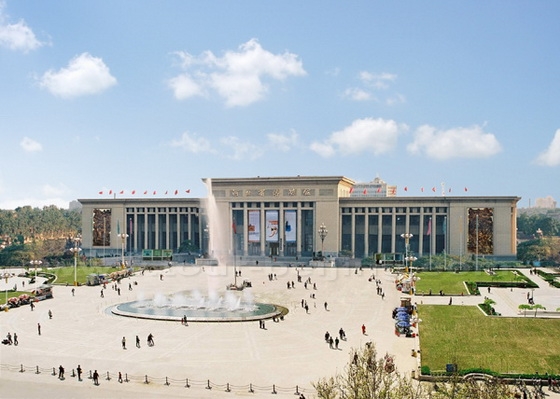
2. Zhaozhou Bridge 赵州桥
The well-known Zhaozhou Bridge, also known as Anji Bridge, was constructed in Sui Dynasty (604 AD – 618AD). It is regarded as the oldest stone-arched bridge in the world at present. It is in Zhaoxian County, 45 km to the southeast of Shijiazhuang.
The Zhaozhou Bridge was designed and built by the famous Li Chun. The bridge is about 50 meters long, 7.3 meters tall with a width of 9 meters. The span of its large stone arch in the middle measures 37.37 meters – the world’s largest arch at that time. The bridge spans over the Xiaohe River.
The bridge remains in good shape, with carefully supported stone structures beneath, and elegantly carved balusters, crowned with stone guardians, making this a highly valued piece for modern architects.
Entrance fee: RMB40
Opening Time: 08:00-17:00
Location: in Zhaoxian County, 45km to the southeast of Shijiazhuang
How to get there:
First take the long-distance bus from Nanjiao Passenger Bus Station of Shijiazhuang (石家庄南焦客运站) to Zhaoxian County (赵县). You get off at Zhaoxian County ( one hour bus ride ). Then take the local taxi to Zhaozhou Bridge ( RMB 5-10, over 10 minutes ).
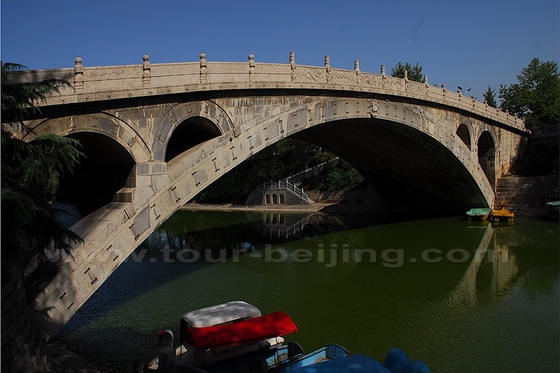
3. Longxing Temple 隆兴寺
Longxing Temple is located in Zhengding County, about 18km north of Shijiazhuang. It is one of the most earliest and largest buddhist monasteries in China. Now it is the national level Relics Protection Unit.
Originally built in 586 AD, the Longxing Temple occupies an area of around 50,000 square meters. Longxing Tenple’s structures and the buildings still keep the Song architectural style. The main buildings comprise Hall of Deva Kings, Hall of Mahamuni, Altar of Vinaya, Pavilion of the Great Mercy and Temple of Amitabha.
The biggest draw in the temple is Monastery’s most impressive statue, a 21 meter high bronze statue of Guanyin, Goddess of Mercy. She has a thousand hands and a thousand eyes, one of the four largest Buddha statues in the north China.
Entrance fee: RMB40
Opening Time: 08:00-16:00
Location: in Zhengding County, 18km north of Shijiazhuang
How to get there:
1)Taxi from Shijiazhuang: RMB30
2) Take the public buses No.201 or 131 from Shijiazhuang to Zhengding County
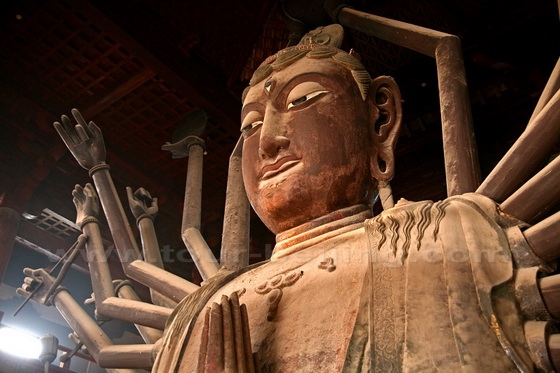
4. Yujia Village (Stone Village) 于家村(石头村)
Yujia Village literally means “Yu Family Village”, named after the fact that 95% of the inhabitants in the village share the same surname of Yu. Yujia Village is located about 60km to the west of Shijiazhuang.
Yujia Village is also known as Stone Village simply because the village is built with various kinds of stones. There are over 40,000 stone houses, stone pathways of over 3,700 meters, more than 1,000 stone wells and kiln pools and over 200 stone tablets. You also can find everything is made of stone – stone buildings, stone courtyards, stone stools, stone desks, stone mills, stone balusters and more. The most impressive is the stone multi-storey courtyard built in Ming Dynasty. The courtyard compound occupies an area of 650 meters with a hundred of rooms.
Entrance fee: RMB20
Opening Time: all day
Location: In Jingxing Conuty, 60km west of Shijiazhuang
How to get there:|
First take the long-distance bus from Shijiazhuang’s Xiwang Bus Station (西王客运站) to Jingxing County (井陉县), then connect the local bus for Yujia Village
5.Cangyanshan (Green Crag Mountain) 苍岩山
Canyanshan Mountain is located 30km to the south of Jingxing County and 70km to the west of Shijiazhuang. The mountain is reputed as a combination of the Five Sacred Mountains and the most beautiful peak of all the peaks in Taihang Mountains in China.
The main draw is a Sui-dynasty palace spanning a precipitous gorge in the mountain. If you feel that you’ve seen it before, it is because the site was one of the locations for the hit film called “Crouching Tigers and Hidden Dragons”.
Entrance fee: RMB50
Opening Time: 9:00 – 16:00
Location: 30km south of Jingxing Conuty, 70km west of Shijiazhuang
How to get there:|
First take the long-distance bus from Shijiazhuang’s Xiwang Bus Station (西王客运站) to directly to Cangyan Shan. Starting at 7:00am and taking 2 hours.
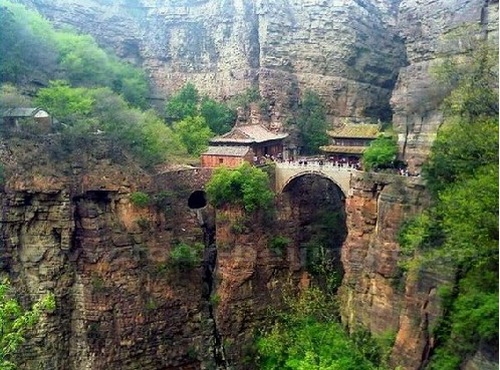
6. Baodu Zhai 抱犊寨
Baodu Zhai refers to Baodu Zhai Mountain as well as the ancient village with the same name that used to be on the mountain. Baodu Zhai is located 16km to the west of Shijiazhuang.
Baoduzhai Mountain abuts Huabei Plain on the east, Taihang Peaks on the west, Jingxing ancient passage on the south of Jingxing. It looks high with stunning views though it only has a sea level of 580 meters.
It s beauty lies in the natural beauty of queer springs, flying waterfalls, ancient caves, mountain lights, mists, sunrise and sunset. It is also rife with ancient relics and historical artifacts scattered in the mountains – temples, tablets, carvings on the caves and more.
Entrance fee: RMB50 (high season); RMB30 (low season)
Opening Time: 9:00 – 17:00
Location: 16 km west of Shijiazhuang
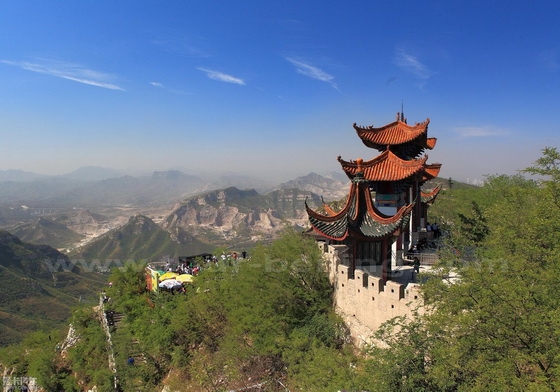
7. Rongguo Mansion 荣国府
If you are interested in one of the Four Chinese Classical Novels known as Dream of the Red Chamber, the reproduction of Rong Mansion or (Rong Guo Fu) is a good place to feel and touch the scenes related to the classical novel.
The architectural complex comprises two parts: the mansion and the street with an area of 37,000 square meters. The mansion has 212 chambers and 102 verandas.
Three roads divides the mansion: the east road, the middle road, and the west road. The middle road is the official yard of Jia Zheng, one of the novel’s characters, while the other two adopt Suzhou-style architecture. Now Rongguo Mansion has become a base for film and TV shooting.
Cao Xueqin memorial, the author of Dream of the Red Chamber is in the southeast part of the residence. The memorial’s pictures and objects vividly represent the notable events in Mr. Cao’s life.
Entrance Fee: RMB30
Add.: No.51, Xingrong Road, Zhengding County, Shijiazhuang
Opening Time: 08:00-17:00
Take the public buses No.201 or 131 from Shijiazhuang to Zhengding County
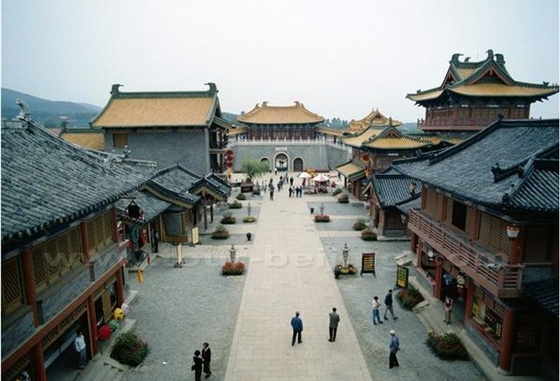
8. Xibaipo Memorial 西柏坡纪念馆
Xibaipo is one of the most famous revolutionary places in China, Xibaipo Memorial Hall is located in Pingshan County, Shijazhuang City, Hebei Province. From May 1948 to March 1949, the Central Committee of the Chinese Communist Party (CCP) and the Chinese People’s Liberation Army set up their headquarters in this village. It represents a transitional period of historical significance for the Chinese revolution — the latter part of the Liberation War (Chinese Civil War).
In Xibaipo, the Party’s Central Committee commanded the Three Major Campaigns in t he Liberation War (Chinese Civil War). This village was also the site of the Second Plenary Session of the Seventh Central Committee of the Chinese Committee Party. In addition, many famous Chinese revolutionaries lived here, such as Mao Tse-tung, Liu Shao-Chi., Chou En-Lai, and Zhude.
With an area of 13,400 square meters, the Xibaipo Memorial is constructed on a mountain side with two-storey courtyard. The advanced audio and video technologies are used to demonstrate the historical events and far-reaching repercussions of Xibaipo.
Add.: In the middle of Pingshan County, 80km northwest of Shijiazhuang
Entrance: Free
Opening Time: 08:30-17:30 (winter); 08:30-18:00 (summer); close on Monday and Sunday afternoon
How to get there:
Take the buses from Shijiazhuang North Station directly to Xibaipo.
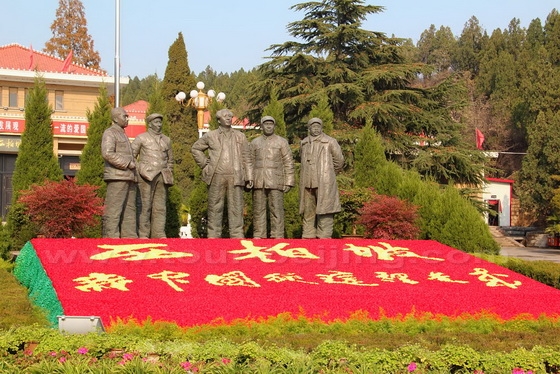
9. Xishan Forest Park 西山森林公园
Xishan Forest Park is located on the foot of Fenglong Mountain, about 20km to the southwest of Shijiazhuang. The park occupies a total area of 25 million square meters with a 75.6% forest coverage. It has 32 scenic spots in the park, a combination of elegance, queerness and grandeur. It is reputed as “Botanical Kingdom” and “Landscape Kingdom”.
The park is divided into two parts – The East Section and West Section. The East Section had several remaining sites related to the Boxing Uprising while the West Section is a summer resort with good natural environment.
Entrance Fee: Free
Add: on the foot of Fenglong Mountain, about 20km to the southwest of Shijiazhuang
Opening Time: 08:00-17:00
How to get there:
Take bus 360 and 318
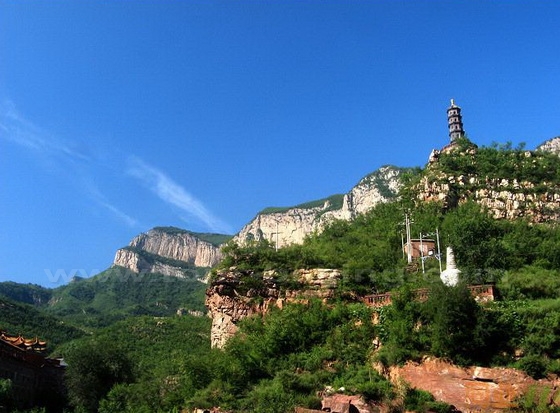
10. Tianguishan Mountain 天桂山
Tianguishan Mountain is situated 95km to the northwest of Shijiazhuang. It is a famous Taoist mountain teemed with queer caves. Its natural beauty is likened to the charming landscape of Guilin.
Tianguishan is famous for its historical buildings and natural landscape. Tianguishan is divided into two peaks – East Peak and West Peak. Most of the scenic spots are perched on the cliffs – Qinglong Taoist Temple, Wanfo Rock, Xuanwu Peak and more.
Entrance Fee: RMB65
Add: 95km to the northwest of Shijiazhuang.
Opening Time: 08:00-18:00
How to get there:
Take the buses from Shijiazhuang North Station directly to the Tianguishan Mountain.
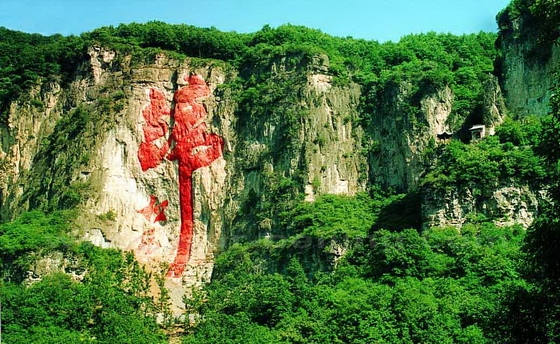
More Travel Information on Shijiahuang
Shijiazhuang Travel Guide
Zhangjiakou Travel Guide
Tangshan Travel Guide
Langfang Travel Guide
Baoding Travel Guide
Cangzhou Travel Guide
Hengshui Travel Guide
Xingtai Travel Guide
Handan Travel Guide
Any questions, just drop a line.






I would like to contract a guinde (chinsese spoken) to visit Cangyanshan (Green Crag Mountain) 苍岩山. Do you know a guide? In October 22nd
Hi Flavio Hirata,
Will you be in Shijiazhuang? Try to locate a local tour guide or just hire a taxi from your hotel to Cangyanshan. Any futher request, please contact us at [email protected].
What is the best way to get to Baodu Zhai from Shijiazhuang please? Is there a bus? Thanks.
Dear Adrien,
Thanks for your inquiry! Best way? Best in terms of the fastest transport? or Best in terms of money-saving?
1) Fastest way: just take a taxi from downtown Shijiahzuang.
2) Money-saving: You may take the Tourism Bus No.05 (游5公交车)starting from People’s Department Store(人民商场)
The bus goes directly to Baodu Zhai. You may ask the local people for the exact location of the bus stop at People’s Department in the downtown Shijiazhuang.
Have a nice time!
Hi ..only have one day in Shijiazhuang..is it possible to see cangyan mountain and glass bridge .if so how much is it hire taxi for this trip
Thanks
Dear Steve,
Thanks for your inquiry!
But for your particular case, basically you need to negotiate with your taxi driver and it is difficult to give you a set price for the trip. Have a nice time!
We will be in Shijiazhuang on 26th July 2024, we need your help to hire a guide to visit Cangyanshan and Qiao Lou
Thank you